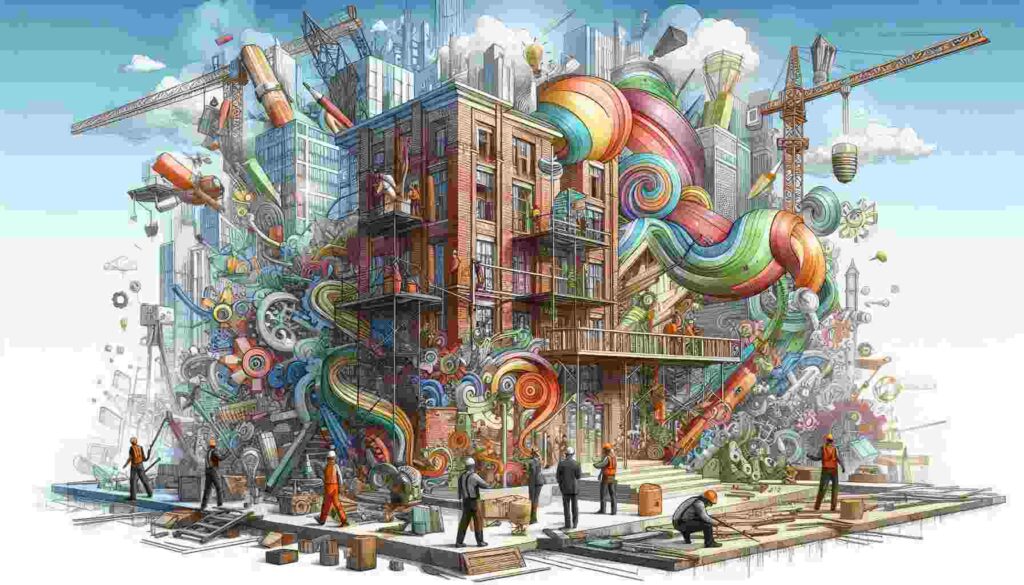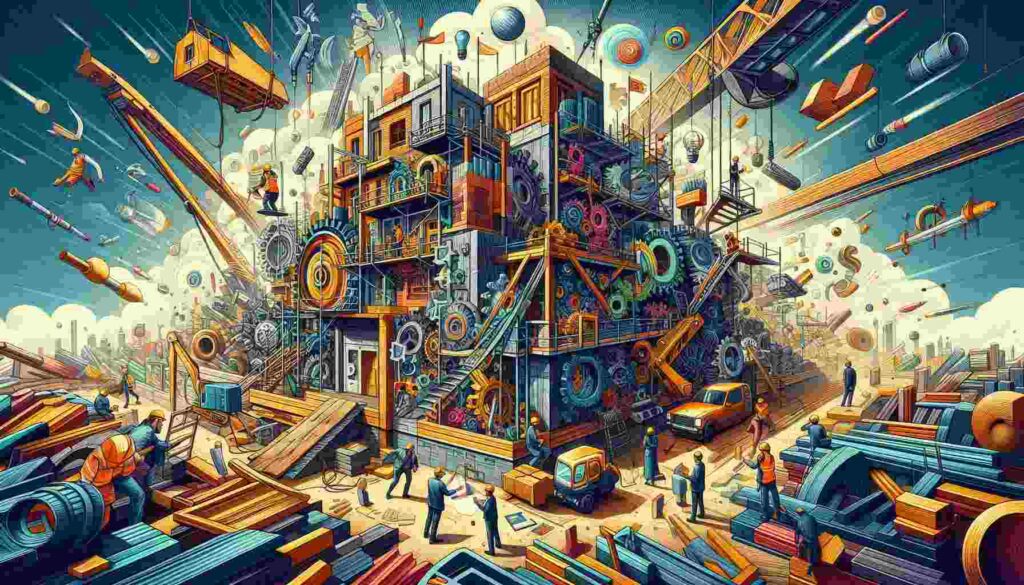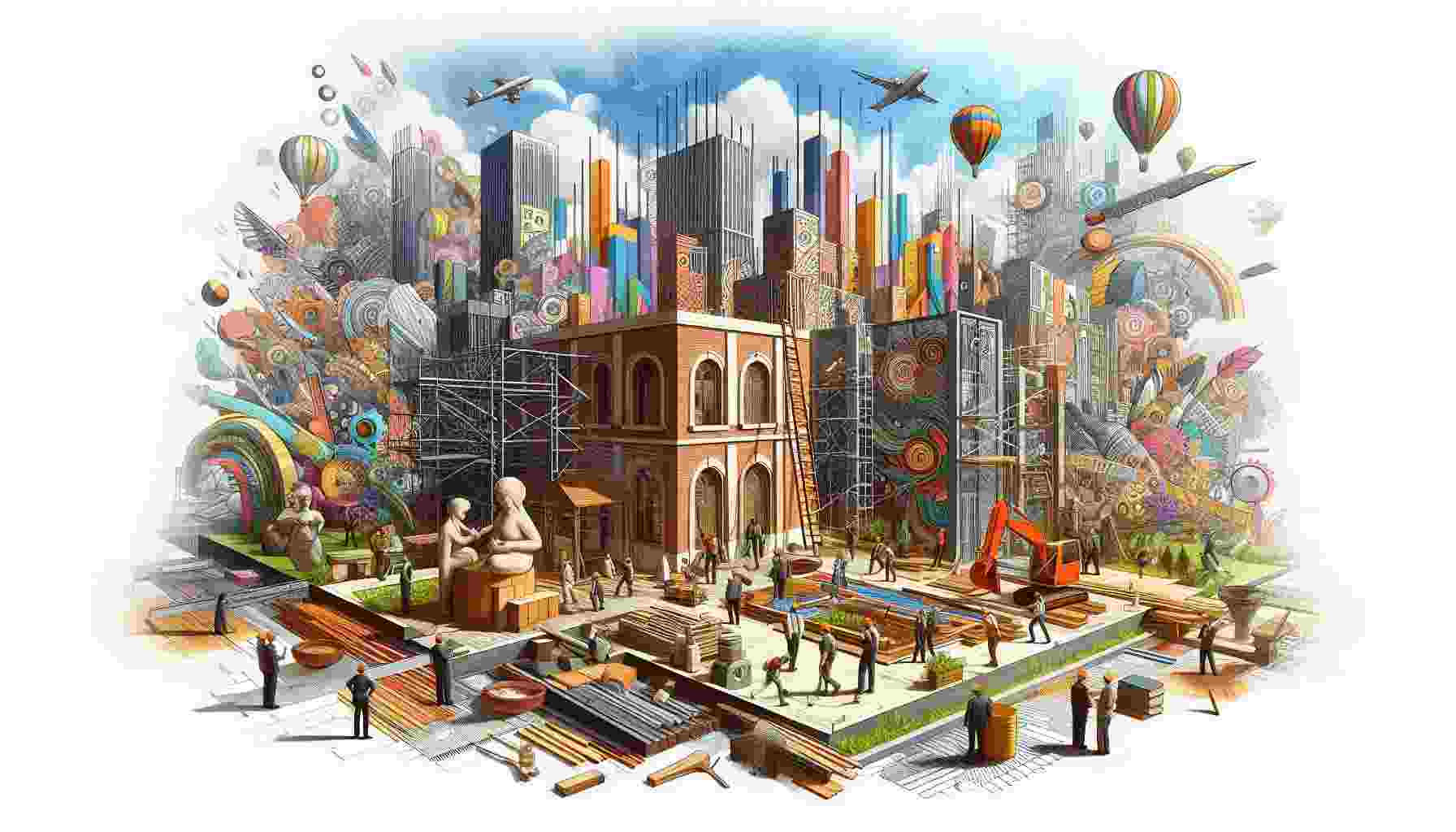Ever heard of the phrase “one man’s trash is another man’s treasure”? Well, that’s exactly what Construction Junction is all about! It’s a magical place where discarded building materials find new life and creative minds run wild. As someone who’s spent countless hours wandering through their aisles, I can tell you it’s like a treasure hunt for DIY enthusiasts and eco-conscious builders alike.
In today’s world of fast consumerism and disposable everything, places like Construction Junction are becoming increasingly important. They’re not just about saving a few bucks on building supplies; they’re about reducing waste, promoting sustainability, and fostering a community of creative problem-solvers.
Key Takeaways
- Construction Junction is a nonprofit that salvages and resells building materials
- It promotes sustainability by reducing construction waste
- Offers affordable materials for DIY projects and home renovations
- Serves as a hub for creative upcycling and community engagement

What Exactly is Construction Junction?
Construction Junction, or CJ as the regulars affectionately call it, is a nonprofit organization that specializes in salvaging and reselling used and surplus building materials. Founded in 1999 in Pittsburgh, Pennsylvania, it’s grown from a small warehouse operation to a 40,000-square-foot facility that’s become a mecca for builders, renovators, and DIY enthusiasts.
But CJ is more than just a store. It’s a community hub, an educational center, and a driving force for sustainability in the construction industry. They don’t just sell stuff; they inspire people to think differently about waste and creativity.
I remember my first visit to CJ like it was yesterday. I walked in looking for some cheap lumber for a backyard project and left with a vintage door, some quirky light fixtures, and a head full of ideas. That’s the magic of Construction Junction – you never know what you’ll find or what it might inspire you to create.
The Environmental Impact
Let’s talk numbers for a sec. Did you know that construction and demolition waste makes up about 40% of the solid waste stream in the United States? That’s a lot of perfectly good materials ending up in landfills. Construction Junction is fighting this wasteful trend one salvaged item at a time.
By diverting usable materials from the waste stream, CJ is making a significant environmental impact. In 2020 alone, they kept over 4 million pounds of materials out of landfills. That’s equivalent to the weight of about 200 school buses!
But it’s not just about the numbers. Every item saved and resold represents:
- Reduced need for new manufacturing
- Less energy consumption
- Fewer raw materials extracted from the earth
- Decreased transportation emissions
It’s a ripple effect that goes far beyond just saving some old doors or windows. And let me tell you, there’s something deeply satisfying about knowing your latest home improvement project is not only beautiful but also kind to the planet.

A Treasure Trove for DIYers
Now, let’s get to the fun part – the stuff you can find at Construction Junction. As someone who’s spent way too much time (and money) there, I can attest to the incredible variety of materials available. We’re talking everything from vintage doorknobs to industrial-sized HVAC systems.
Some of my favorite finds over the years have included:
- A set of 1920s stained glass windows that now serve as a room divider in my home
- Reclaimed barn wood that became a stunning accent wall
- Vintage bathroom fixtures that gave my renovation project some serious character
- Surplus ceramic tiles that turned into a unique kitchen backsplash
The best part? These materials often cost a fraction of what you’d pay for new items. It’s a budget-friendly way to add unique character to your space. Plus, there’s the thrill of the hunt – you never know what gems you might uncover on any given day.
Inspiring Creativity and Upcycling
One of the things I love most about Construction Junction is how it inspires creativity. When you’re surrounded by such a diverse array of materials, it’s hard not to let your imagination run wild. I’ve seen people turn old doors into headboards, transform industrial light fixtures into statement pieces, and repurpose vintage sinks into garden planters.
CJ doesn’t just provide materials; they provide possibilities. They regularly host workshops and events to teach upcycling techniques and inspire creative reuse. I once attended a workshop on turning reclaimed wood into furniture, and it completely changed how I approach DIY projects.
The staff at CJ are also a wealth of knowledge. They’re always happy to share ideas and advice on how to use different materials. I’ve lost count of the times I’ve gone in with a vague idea and left with a solid plan, thanks to their suggestions.
But the creativity extends beyond individual projects. Construction Junction has become a hub for artists and makers in the community. They collaborate with local artists to create installations from salvaged materials, showcasing the potential of these discarded items.
As we continue to explore the world of Construction Junction, we’ll delve into how this unique organization is shaping the future of sustainable building and community engagement. From their educational programs to their impact on local businesses, there’s so much more to discover about this innovative reuse center.

From Salvage to Showcase: CJ’s Art Initiatives
Construction Junction’s commitment to creativity goes beyond just providing materials. They’ve developed several initiatives that showcase the artistic potential of salvaged items:
- Annual Art Show: Each year, CJ hosts an exhibition featuring works created entirely from materials found in their warehouse. It’s a stunning display of creativity and a powerful statement about the value of reuse.
- Artist in Residence Program: CJ invites local artists to spend time in the warehouse, creating pieces that are then displayed and sold in the store. This program not only supports local artists but also demonstrates the artistic potential of salvaged materials.
- Community Art Projects: CJ often partners with schools and community organizations to create public art installations using reclaimed materials. These projects beautify the community while educating people about creative reuse.
- Upcycling Challenges: Periodically, CJ hosts competitions challenging participants to create something amazing from a specific salvaged item. These events spark incredible creativity and often result in truly innovative designs.
These initiatives not only showcase the potential of salvaged materials but also help to build a community around the principles of creative reuse and sustainability.
Educational Outreach and Community Impact
Construction Junction’s impact extends far beyond its warehouse walls. They’ve developed a robust educational program that reaches out to schools, community groups, and aspiring DIYers of all ages. Here’s a closer look at some of their initiatives:
- School Programs: CJ offers field trips and in-school workshops that teach students about sustainability, waste reduction, and creative reuse. These programs often include hands-on projects, giving kids practical experience in upcycling.
- Community Workshops: Regular workshops cover topics like basic carpentry, furniture restoration, and sustainable home improvement. These sessions empower community members to take on their own projects and embrace the principles of reuse.
- Professional Development: CJ provides training for contractors and architects on incorporating salvaged materials into their projects. This helps to spread sustainable building practices throughout the professional community.
- Volunteer Programs: By offering volunteer opportunities, CJ allows community members to get hands-on experience in sustainable practices while contributing to the organization’s mission.
- Partnerships with Local Organizations: CJ collaborates with other nonprofits, providing materials for community projects and supporting initiatives that align with their mission of sustainability and community development.
Through these programs, Construction Junction is not just changing how people think about waste and reuse; they’re building a community of environmentally conscious, creatively empowered individuals.
The Ripple Effect: Impact on Local Businesses and Economy
The influence of Construction Junction extends into the local business ecosystem in fascinating ways. By providing affordable materials and inspiring creative reuse, CJ has indirectly supported the growth of numerous small businesses and artisan ventures. Here are a few examples:
- Furniture Upcyclers: Several local furniture makers have built businesses around transforming salvaged materials from CJ into high-end, custom pieces.
- Architectural Salvage Specialists: Inspired by CJ’s model, some individuals have started businesses specializing in salvaging and reselling unique architectural elements.
- Eco-Friendly Contractors: A number of local contractors have differentiated themselves by specializing in renovations using reclaimed materials, often sourced from CJ.
- Artisanal Crafters: Many local artists and crafters rely on CJ for unique materials that become part of their creations, from jewelry made from old hardware to sculptures crafted from industrial scraps.
- Green Building Consultants: The expertise developed around working with salvaged materials has led to the emergence of consultants who specialize in advising on sustainable building practices.
By supporting these businesses, Construction Junction is contributing to a more diverse, sustainable local economy. It’s a beautiful example of how one organization’s mission can have far-reaching effects on a community.
Challenges and Future Directions
While Construction Junction has achieved remarkable success, it’s not without its challenges. As the organization looks to the future, it faces several key issues:
- Space Constraints: Despite its large warehouse, CJ often struggles with storage space for larger items. They’re constantly having to make tough decisions about what to accept and what to turn away.
- Increasing Demand: As awareness of sustainability grows, so does the demand for salvaged materials. Meeting this demand while maintaining quality and affordability is an ongoing challenge.
- Changing Building Codes: As building codes evolve, some older materials become more difficult to repurpose. CJ needs to stay informed about these changes and adapt accordingly.
- Education and Outreach: There’s still a significant portion of the population unfamiliar with the benefits of using salvaged materials. Continuing to expand educational efforts is crucial.
- Funding: As a nonprofit, CJ relies on a combination of sales, grants, and donations. Ensuring stable funding to support their programs and growth is an ongoing concern.
Looking to the future, Construction Junction has several exciting directions they’re exploring:
- Expansion: There’s talk of opening satellite locations to serve more communities and salvage materials from a wider area.
- Online Sales: While the in-person experience is crucial, CJ is looking at ways to expand their online presence to reach more customers.
- Advanced Recycling: They’re exploring partnerships with recycling technology companies to find new ways to repurpose materials that currently can’t be easily reused.
- Policy Advocacy: CJ is becoming more involved in advocating for policies that support building material reuse and sustainable construction practices.
- Research Partnerships: Collaborations with local universities are in the works to study and quantify the environmental impact of building material reuse.
As we look to a future where sustainability is not just desirable but necessary, organizations like Construction Junction will play an increasingly vital role. They’re not just saving materials from landfills; they’re changing how we think about waste, creativity, and the potential hidden in the things we too often discard.
In conclusion, Construction Junction is more than just a warehouse of used building materials. It’s a catalyst for creativity, a champion of sustainability, and a cornerstone of community. Whether you’re a DIY enthusiast, a professional builder, an artist, or just someone who cares about the environment, CJ has something to offer. It’s a place where the past finds new purpose, where waste becomes wonder, and where one person’s trash truly does become another’s treasure.
So next time you’re planning a home project, considering a renovation, or just feeling the itch to create something unique, consider a trip to Construction Junction. You never know what treasures you might find or what inspiration might strike. And remember, every nail, every board, and every quirky old doorknob you rescue is a small victory for our planet. Happy hunting!
Construction Junction: Frequently Asked Questions (FAQs)
Q: What is Construction Junction?
A: Construction Junction (CJ) is a nonprofit organization that specializes in salvaging and reselling used and surplus building materials. Located in Pittsburgh, Pennsylvania, it serves as a hub for sustainable building practices, DIY projects, and creative upcycling.
Q: What kinds of materials can I find at Construction Junction?
A: CJ offers a wide variety of salvaged and surplus building materials, including but not limited to: doors, windows, lumber, tiles, plumbing fixtures, lighting fixtures, hardware, appliances, and even unique architectural elements. The inventory changes regularly based on donations and salvage operations.
Q: How does Construction Junction acquire its materials?
A: CJ obtains materials through various channels:
- Donations from individuals and businesses
- Salvage operations at demolition sites
- Partnerships with contractors and builders who have surplus materials
- Collaborations with manufacturers who may have overstock or discontinued items
Q: Is everything at Construction Junction used or old?
A: While many items are salvaged from older buildings, CJ also receives new and unused materials. These might come from overstock, discontinued lines, or projects where materials were ordered in excess. You can find both vintage items and brand-new materials at CJ.
Q: How does shopping at Construction Junction benefit the environment?
A: Shopping at CJ has several environmental benefits:
- It diverts usable materials from landfills
- It reduces the demand for new manufacturing, saving energy and resources
- It decreases transportation emissions associated with new material production
- It promotes a culture of reuse and sustainability in the construction industry
Q: Can I donate materials to Construction Junction?
A: Yes! CJ accepts donations of usable building materials. However, they have guidelines on what they can accept due to space limitations and demand. It’s best to check their website or call ahead to ensure they can take your specific items.
Q: Does Construction Junction offer any educational programs or workshops?
A: Yes, CJ regularly hosts workshops and events on topics such as:
- DIY home improvement
- Furniture restoration
- Upcycling techniques
- Sustainable building practices
They also offer educational programs for schools and community groups.
Q: Are the prices at Construction Junction negotiable?
A: Generally, prices at CJ are fixed and clearly marked. However, for some larger items or bulk purchases, there may be room for negotiation. It’s always worth asking a staff member if you’re interested in a significant purchase.
Q: Does Construction Junction offer delivery services?
A: CJ typically does not offer delivery services. Customers are responsible for transporting their purchases. However, for very large items, CJ may be able to recommend local delivery services.
Q: How can I get involved with Construction Junction beyond shopping?
A: There are several ways to get involved with CJ:
- Volunteer: CJ often needs help with sorting and organizing materials
- Attend events: Participate in workshops, art shows, or community events
- Spread the word: Tell friends and family about CJ and the importance of building material reuse
- Donate: Besides materials, CJ also accepts financial donations to support their nonprofit mission
- Professional partnerships: If you’re a contractor or builder, consider partnering with CJ for your salvage needs or material donations






